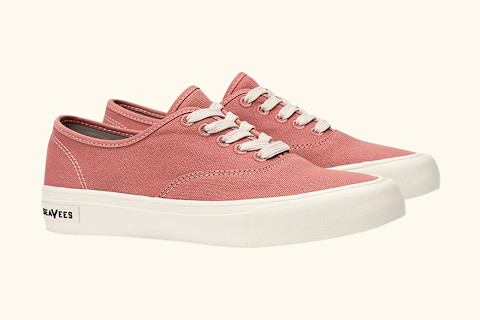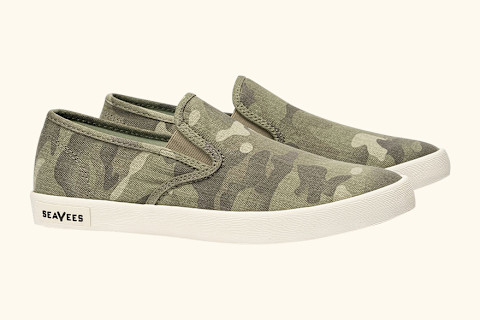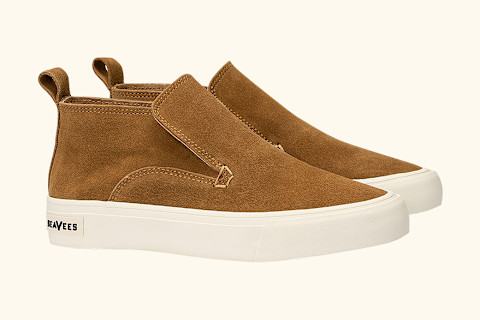What's The Footprint Of Your Footwear? Here's How To Take A Step In The Right Direction

Understanding what goes into the products we buy—ingredients, materials, packaging—is one of the first steps of being a conscious consumer. But when was the last time you thought about where all the stuff in your shoes came from?
Footwear is responsible for as much as a third of the environmental impact generated by the entire fashion industry, despite accounting for less than a tenth of the industry's total value. In other words, your shoes are probably leaving a big footprint, and footwear brands have been heading back to the drawing board for solutions to offset the damage. Some, like the Santa Barbara, California–based company SeaVees, are racing to do it.
The making of a more sustainable shoe.
"Not to be dramatic, but this is less of a light bulb moment and more of a hazard warning light," SeaVees product line manager Ashley Tammietti Aceves tells mbg. She's talking about the brand's idea for the new SeaChange collection, SeaVees' first almost entirely recycled iteration of their classic, bestselling sneaker. "Being based on the coast gives us a real front-row seat to the destruction that is happening to our environment both on land and at sea."

Each SeaChange pair that's sold helps support the conservation nonprofit SeaTrees, which works to reverse climate change by regenerating kelp forests that sequester carbon and help restore coastal ecosystems and ocean health. It's a natural move for SeaVees, a 1% for the Planet partner since 2012. "We've always been conscious of the importance of protecting our resources, but with the recent devastating wildfires, flooding, and mudslides right in our own backyard, the need to do what we can—as quickly as possible—has been top of mind. We wouldn't be responsible human beings if we didn't make changes where we can right now."
For a shoe manufacturer, those changes look like circular, eco-minded design and responsibly sourced, sustainable materials. The SeaChange sneaker specifically is the result of the SeaVees design team rethinking several key components of the shoe:
- Recycled canvas uppers: "Sourcing a recycled cotton canvas that doesn't hinder the durability or quality of the shoe was a worthwhile feat," says Aceves. "We found beautiful articles from Spain, Japan, and China that—despite the added expense—still had all the attributes we look for when making a beautiful sneaker. We plan to include the recycled canvas used in SeaChange across our entire collection in 2020."
- Recycled rubber outsole: "The most obvious and interesting-looking component of the SeaChange collection is the recycled rubber outsole," says Aceves. "Seeing the ground-up pieces of rubber from all sorts of origins, in a ton of colors, repurposed as a part of a shoe, really puts into perspective how much extra rubber and waste is out there."
- Post-consumer recycled plastic laces: "We've always been proud of the quality of our cotton laces—their tight weave, perfect color, and extreme durability," Aceves says. "But after meeting with multiple suppliers, we found what might be our favorite lace yet—with the added bonus of being made from post-consumer plastic. This lace will also be used throughout the entire collection by the end of 2020."
- Metal-free stitched eyelets: "The design philosophy of 'less is more' is a running theme in the SeaVees zeitgeist. Removing our metal eyelets not only leaned into the clean minimalism of SeaChange but also enabled us to use fewer resources for the end result."
Take 20% off your SeaVees purchase using discount code MBG20!
How to dispose of your shoes responsibly.
In sustainability, we can't talk about the beginning of a product's life without talking about its end of life. What happens when your shoes are worn to the point of no return is just as important as how they got here. Globally, 24.2 billion pairs of shoes are manufactured each year, and most of these kicks just end up in landfills.
There, decomposing organic shoe materials like leather release methane, which is 28 times more impactful1 to the climate than carbon dioxide. While we wait for footwear recycling options to expand, here are a few things we can do instead of tossing 'em out with the garbage:
Donate them. If your shoes are still in usable condition, donating them can give them another chance to wear out—with one big caveat: There's no guarantee your shoes will find a second home, and it's likely they could also end up in a developing country's landfill.
Ship them out. A zero-waste shoe box like this one, which accepts all kinds of shoes, gets shipped via FedEx once they're full for recycling. Purchasing one can get pricey, so tag a few friends to do it with you.
Find a textile drop-off bin or a take-back program near you. A clothing/shoe drop-off bin can help ensure it goes to the right recycling facility. Also, check to see if your shoe brand has a take-back program—many offer this for proper shoe recycling and often give you a discount on your next pair. Some companies, like SeaVees, have in-store initiatives that accept your beat-up shoes, regardless of the brand.
Keep them kicking. Wear your shoes as long as they last. And if you're able, buying higher-quality shoes that will last longer to begin with is just another way to practice the first "R" in reduce, reuse, recycle.
Hey mbg readers! Take 20% off your SeaVees purchase using discount code MBG20.






